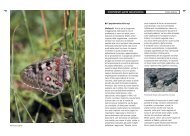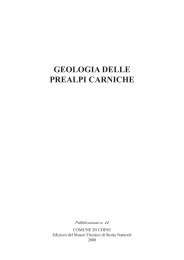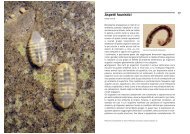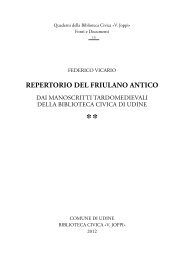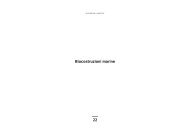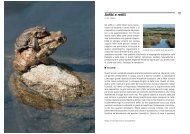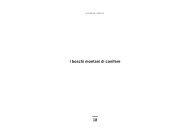Despite its inhospitable appearance and lack of any ... - Udine Cultura
Despite its inhospitable appearance and lack of any ... - Udine Cultura
Despite its inhospitable appearance and lack of any ... - Udine Cultura
Create successful ePaper yourself
Turn your PDF publications into a flip-book with our unique Google optimized e-Paper software.
84 85<br />
The discovery <strong>of</strong> a new submerged world: anchialine environments<br />
Diana Maria Paola Galassi<br />
Anchialine environments were first<br />
discovered in 1966, when the Austrian<br />
scientist Rupert Riedl described them<br />
as “marginal caves”. Since then,<br />
experts have debated the correct<br />
definition <strong>of</strong> anchialine systems. Today,<br />
they agree on defining them as caves<br />
or other underground aquatic habitats<br />
near the coastline <strong>of</strong> isl<strong>and</strong>s <strong>and</strong><br />
continents, supplied by continental<br />
freshwater <strong>and</strong> with underground<br />
connections to the sea. Consequently,<br />
the water <strong>of</strong> anchialine pools is<br />
brackish, <strong>and</strong> light-weight freshwater<br />
generally floats on top <strong>of</strong> heavier<br />
seawater.<br />
The most typical feature <strong>of</strong> anchialine<br />
environments is the absence <strong>of</strong> a<br />
surface connection with the sea, which<br />
manages to reach far inl<strong>and</strong> through<br />
deep infiltration passages in limestone<br />
<strong>and</strong> volcanic rocks.<br />
The most fascinating, extraordinary<br />
examples are the well-known Mexican<br />
cenotes, small bodies <strong>of</strong> crystalline<br />
brackish water, like blue eyes glittering<br />
in the tropical forests <strong>of</strong> Mexico <strong>and</strong><br />
Belize, not far from the coast. In Italy,<br />
typical anchialine pools are found in<br />
the Grotta Zinzulusa, Abisso <strong>and</strong> Buco<br />
dei Diavoli (Salento), together with<br />
other water-tables in Apulia,<br />
groundwater in Porto Palo (Sicily), the<br />
Grotta Verde, Grotta di Nettuno <strong>and</strong><br />
Grotta del Bue Marino (Sardinia) <strong>and</strong><br />
the Grotta di Punta degli Stretti<br />
(Argentario, Tusc<strong>any</strong>).<br />
Anchialine pools are marked by few<br />
food resources, total darkness, <strong>and</strong><br />
vertical gradients <strong>of</strong> salinity <strong>and</strong><br />
oxygen concentrations. Although in the<br />
past anchialine ecosystems were<br />
believed to support themselves on<br />
allochthonous organic matter (deriving<br />
from the rock above <strong>and</strong> from<br />
seawater), today we know that part <strong>of</strong><br />
the organic matter is locally<br />
synthesised by chemo-autotrophs.<br />
The most fascinating aspect that<br />
makes these environments true treasure<br />
troves <strong>of</strong> biodiversity is their exclusive<br />
fauna. Examples are remipedes, the<br />
most primitive class <strong>of</strong> living<br />
crustaceans, which have been found in<br />
anchialine caves on the Bahamas, in<br />
lava tubes on the isl<strong>and</strong> <strong>of</strong> Lanzarote<br />
<strong>and</strong>, more recently, in Australia.<br />
Remipedes, like m<strong>any</strong> other animal<br />
groups found in these habitats, are true<br />
living fossils, whose distribution,<br />
enigmatically uneven in several areas<br />
<strong>of</strong> the world, dates back to the breakup<br />
<strong>of</strong> the ancient Tethys Sea.<br />
In addition to these unique organisms,<br />
there are also other extraordinary<br />
animals, some <strong>of</strong> which are Italian<br />
endemics with restricted distribution,<br />
like the sponge Higginsia ciccaresei,<br />
the thermosbaenacean Monodella<br />
stygicola, the mysid Stygiomysis<br />
hydruntina, <strong>and</strong> the decapod<br />
Typhlocaris salentina.<br />
It is worth noting that the copepod<br />
Muceddina multispinosa was recently<br />
discovered in the Grotta Verde (Capo<br />
Caccia, Alghero, Sardinia), a species<br />
with disjunct distribution also found in<br />
anchialine environments on the isl<strong>and</strong>s<br />
<strong>of</strong> Mallorca <strong>and</strong> Lanzarote (Spain).<br />
Generally speaking, anchialine habitats<br />
host heterogeneous assemblages<br />
which includes strictly marine animals<br />
<strong>and</strong>, to a lesser degree, freshwater<br />
organisms.<br />
Typically anchialine species are closely<br />
associated with the particular<br />
environment in which they live, <strong>and</strong><br />
have never been found in other types <strong>of</strong><br />
underground habitats. They are also<br />
stygobionts, <strong>and</strong> have marked<br />
specialised features. Their origin dates<br />
back to various geological times, from<br />
the Tertiary to the more recent<br />
Sea entrance to the Grotta Zinzulusa (Salento, Apulia)<br />
Pleistocene. Some researchers believe<br />
that their ancestors lived in the abysses<br />
<strong>of</strong> the sea; others trace their origin back<br />
to organisms living in shallow seawater<br />
on the continental shelf.




